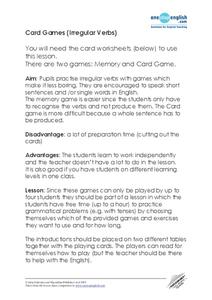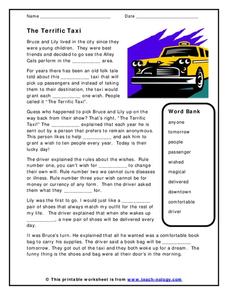Scholasic
The Magic School Bus and the Missing Tooth
We chew with our teeth every day, but how much do we really know about them? Allow Ms. Frizzle to teach your kids a thing or two about teeth. Kids complete a prereading exercise, read the book, and respond to several prompts about the...
Federal Reserve Bank
Glo Goes Shopping
Making decisions can be very difficult. Show your class one way to evaluate choices with this lesson, which is inspired by the book Glo Goes Shopping. Learners practicing using a decision-making grid with the content of the story and a...
Curated OER
Hatchet: Vocabulary Strategy
Want your class to use critical thinking when discussing vocabulary? Go beyond the dictionary with a vocabulary activity based on Gary Paulsen's Hatchet. Kids write the word in the center of a graphic organizer that also provides places...
Macmillan Education
Card Games: Irregular Verbs
Who says learning grammar can't be fun? Focusing on commonly used irregular verbs, this pair of card games helps young grammarians learn different tenses for verbs that fail to follow the regular rules of conjugation.
Teach-nology
Author’s Purpose
What is the author's purpose in writing a joke book? What about a book about the digestive system? Explore author's purpose with a worksheet that challenges kids to identify whether ten books are meant to entertain, inform, or persuade.
Have Fun Teaching
When Am I? (16)
How can you tell when a story takes place? Use context clues to infer the time of day and seasons of five short reading passages. Kids then note each passage's time period as daytime or nighttime, as well as winter or summer.
Have Fun Teaching
Where Am I? (15)
Guess the setting in a series of reading passages that allow learners to make inferences. Five short descriptions prompt kids to match one of four settings, based on context clues.
Texas Center for Learning Disabilities
Second-Grade Comprehension-Based Intervention
Help your youngsters find meaning in the text they read with this series of five intervention lessons. Offering explicit, step-by-step instructions for walking children through shared readings of leveled books, these...
Texas Center for Learning Disabilities
Second and Third Grade Explicit Phonics Intervention
Support all young learners on their journey to literacy with this five-lesson reading intervention unit. Following a clearly outlined format, each lesson first engages children in practicing their phonemic awareness and phonics skills...
Reading Resource
Cars Puzzles (Basic Code Sentences)
Vroom vroom into reading skills! Bring a set of reading puzzles based on Disney's Cars to your special education or mainstream class. Each strip features a code sentence with the same vowel sound, and when kids put the strips together,...
Reading Resource
Word Wall Pizza
Learning can be as satisfying as a delicious piece of pizza. Have kids write the words from a sight word list on the crusts of each slice of pizza, and when they hear their sight word, they can color in the matching pepperoni.
Reading Resource
Take Me Out to the Ballgame Card Game
Buy me some peanuts and cracker jack! Inspire some competition between your learners with a baseball-themed reading game. Players take turns reading as many words as they can, and once they reach a card they can't read, they tally up...
E Reading Worksheets
Making Predictions #4
Show young readers how to use evidence from the text in an activity about making predictions. After reading five short passages, kids note what they think will happen next based on what they have read, and include the evidence that...
Teach-nology
The Terrific Taxi
What would you wish for if you were granted one wish? Kids read a story about a taxi that bestows wishes upon its passengers in a short cloze activity. They use ten words at the bottom of the page to fill in the blanks throughout the...
Museum of Disability
Buddy, The First Seeing Eye Dog
Learn about how the seeing eye dog program began with a reading lesson about Eva Moore's chapter book, Buddy, The First Seeing Eye Dog. With vocabulary words, discussion questions, and extension resources, the lesson is a great way for...
K5 Learning
Ann and Frank
Challenge your third and fourth graders to look deeply into a text with a reading comprehension activity. After learners finish the short passage, they answer four questions that range in levels of difficulty and analysis.
K5 Learning
Saving the Birds
Learn about the kindness and strength of Abraham Lincoln with a reading comprehension activity. After third and fourth graders read a short story about Lincoln saving a family of robins, they answer four questions about the plot and...
K5 Learning
The Eagle and the Fox
How does a fox outsmart an eagle and all the creatures of the sea? Read about a tricky fox with a short story, followed by four comprehension questions about the plot and another possible endings.
Curated OER
Using Homophones
Never mix up principle and principal again with a helpful homophones worksheet. Featuring ten pairs of words that have the same sounds but different meanings, the worksheet prompts your class to fill in the blanks with the appropriate...
Mrs. Warner's Learning Community
Their There They’re
There's a great way for your learners to practice their homophones, and they won't even realize they're studying! A baseball-themed worksheet prompts your class to fill in there, they're, or their in the appropriate spaces.
Pearson
Object Pronouns Grammar Activities
Young grammarians put a sentence together with the help of a short, straightforward grammar worksheet. Learners match subject and object pronouns before unscrambling the parts of five different sentences.
K12 Reader
Using Collective Nouns
What do you call a group of soccer players? Or a bunch of bees? Young grammarians review eight sentences and add the correct collective noun based on the context clues they observe.
School Specialty
The Tortoise and the Hare - Drawing Conclusions/Predictions Outcomes
Does the fastest one always win the race? Look deeper into The Tortoise and the Hare with a set of discussion questions for before, during, and after reading the story.
Pearson
Past Time
How do you talk about things that have already happened? What about things that happened in the past and are still happening? Explore past, past perfect, and past progressive verb tenses in a helpful slideshow presentation.
Other popular searches
- English Language Arts
- English Language Arts Exam
- English Language Arts Games
- Deaf English Language Arts
- English Language Arts Music
- English Language Arts Heroes
- English Language Arts Skills
- English Language Arts Grade 3
- English/language Arts
- English Language Arts Poetry
- English Language Arts Rating=3
- English Language Arts Unit Sc

























